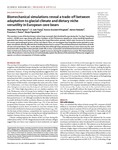Mostrar o rexistro simple do ítem
Biomechanical simulations reveal a trade-off between adaptation to glacial climate and dietary niche versatility in European cave bears
| dc.contributor.author | Pérez-Ramos, Alejandro | |
| dc.contributor.author | Tseng, Z. Jack | |
| dc.contributor.author | Grandal-d'Anglade, Aurora | |
| dc.contributor.author | Rabeder, G. | |
| dc.contributor.author | Pastor, Francisco J. | |
| dc.contributor.author | Figueirido, Borja | |
| dc.date.accessioned | 2020-05-19T10:58:21Z | |
| dc.date.available | 2020-05-19T10:58:21Z | |
| dc.date.issued | 2020-04-01 | |
| dc.identifier.citation | A. Pérez-Ramos, Z. J. Tseng, A. Grandal-D’Anglade, G. Rabeder, F. J. Pastor, B. Figueirido, Biomechanical simulations reveal a trade-off between adaptation to glacial climate and dietary niche versatility in European cave bears. Sci. Adv. 6, eaay9462 (2020). | es_ES |
| dc.identifier.issn | 2375-2548 | |
| dc.identifier.uri | http://hdl.handle.net/2183/25598 | |
| dc.description.abstract | [Abstract] The cave bear is one of the best known extinct large mammals that inhabited Europe during the “Ice Age,” becoming extinct ≈24,000 years ago along with other members of the Pleistocene megafauna. Long-standing hypotheses speculate that many cave bears died during their long hibernation periods, which were necessary to overcome the severe and prolonged winters of the Last Glacial. Here, we investigate how long hibernation periods in cave bears would have directly affected their feeding biomechanics using CT-based biomechanical simulations of skulls of cave and extant bears. Our results demonstrate that although large paranasal sinuses were necessary for, and consistent with, long hibernation periods, trade-offs in sinus-associated cranial biomechanical traits restricted cave bears to feed exclusively on low energetic vegetal resources during the predormancy period. This biomechanical trade-off constitutes a new key factor to mechanistically explain the demise of this dominant Pleistocene megafaunal species as a direct consequence of climate cooling. | es_ES |
| dc.description.sponsorship | Ministerio de Economía y Competitividad; CGL2012-37866 | es_ES |
| dc.description.sponsorship | Ministerio de Economía y Competitividad; CGL2015-68300P | es_ES |
| dc.description.sponsorship | Ministerio de Economía y Competitividad; BES-2013-065469 | es_ES |
| dc.description.sponsorship | Ministerio de Economía y Competitividad; CGL2014-57209-P | es_ES |
| dc.language.iso | eng | es_ES |
| dc.publisher | American Association for the Advancement of Science | es_ES |
| dc.relation | info:eu-repo/grantAgreement/MINECO/Plan Estatal de Investigación Científica y Técnica y de Innovación 2013-2016/CGL2014-57209-P/ES/GEODINAMICA, PALEOGENETICA Y BIOGEOQUIMICA ISOTOPICA EN EL CUATERNARIO DE LA PENINSULA IBERICA | |
| dc.relation.uri | https://doi.org/10.1126/sciadv.aay9462 | es_ES |
| dc.rights | Atribución-NoComercial 4.0 España | es_ES |
| dc.rights.uri | http://creativecommons.org/licenses/by-nc/4.0/es/ | |
| dc.subject | Ursus spelaeus | es_ES |
| dc.subject | Biomechanics | es_ES |
| dc.subject | Paranasal sinuses | es_ES |
| dc.subject | Hibernation | es_ES |
| dc.title | Biomechanical simulations reveal a trade-off between adaptation to glacial climate and dietary niche versatility in European cave bears | es_ES |
| dc.type | info:eu-repo/semantics/article | es_ES |
| dc.rights.access | info:eu-repo/semantics/openAccess | es_ES |
| UDC.journalTitle | Science Advances | es_ES |
| UDC.volume | 6 | es_ES |
| UDC.issue | 14 | es_ES |
| UDC.startPage | eaay9462 | es_ES |
Ficheiros no ítem
Este ítem aparece na(s) seguinte(s) colección(s)
-
IUX-CULXEO - Artigos [64]






